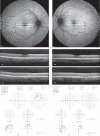Outcomes of screening for hydroxychloroquine retinopathy at the Manchester Royal Eye Hospital: 2 years' audit
- PMID: 35764873
- PMCID: PMC10170114
- DOI: 10.1038/s41433-022-02159-3
Outcomes of screening for hydroxychloroquine retinopathy at the Manchester Royal Eye Hospital: 2 years' audit
Abstract
Background: The Royal College of Ophthalmologists has produced guidelines for screening for hydroxychloroquine retinopathy. New imaging modalities had suggested an increased prevalence of retinopathy compared with previous reports. The aim of this study is to identify the real-life prevalence of hydroxychloroquine retinopathy in patients attending Manchester Royal Eye Hospital screening service over a 2-year period using The RCOphth diagnostic criteria.
Methods: Data were collected prospectively from all patients attending Manchester Royal Eye Hospital hydroxychloroquine screening service over the audit period. Results of Humphrey visual field tests, spectral-domain optical coherence tomography and fundus autofluorescence were collected as well as data on dose, indication, duration of treatment, and additional risk factors. Cases were identified as having definite, possible, or no retinopathy based on the 2018 RCOphth criteria. The data are not publicly available due to information that could compromise research participant privacy and confidentiality but are available upon request from the corresponding author.
Results: 910 patients attended for screening. 566 were identified as being at risk of retinopathy (543 had been on treatment >5 years, 10 had renal impairment, 12 were on doses of >5 mg/kg/day, and one was concurrently on tamoxifen). The prevalence of HCQ retinopathy was 10/910 (1.09%) of all those screened, and 1.76% of those at risk (10/566). Six patients of those deemed at risk were identified as having definite hydroxychloroquine retinopathy, while four had possible retinopathy.
Conclusions: Our results show a prevalence of retinopathy largely consistent with reports from regional audits yet reveal a far lower estimate compared to previously reported figures.
© 2022. The Author(s), under exclusive licence to The Royal College of Ophthalmologists.
Conflict of interest statement
The authors declare no competing interests.
Figures


References
-
- National Guideline Centre (UK . Rheumatoid arthritis in adults: diagnosis and management. London: National Institute for Health and Care Excellence (UK); 2018. - PubMed
MeSH terms
Substances
LinkOut - more resources
Full Text Sources
Medical

